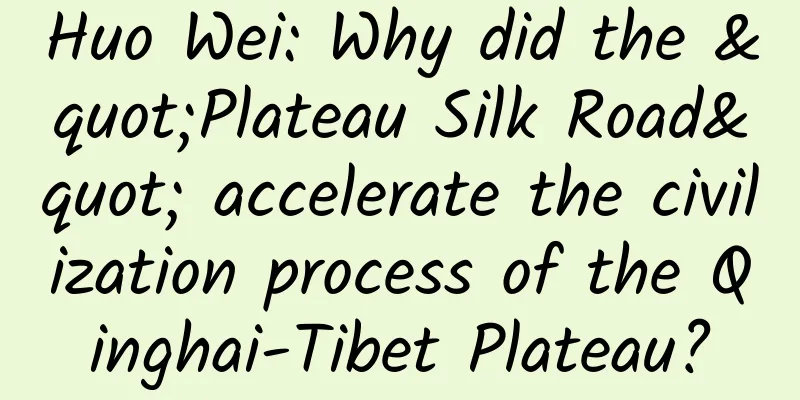Huo Wei: Why did the "Plateau Silk Road" accelerate the civilization process of the Qinghai-Tibet Plateau?

|
The Plateau Silk Road is like a "blood supply system", continuously injecting fresh blood into the Qinghai-Tibet Plateau, accelerating its civilization process, and playing a linking role in the ultimate integration of the various ethnic groups on the plateau into the Chinese civilization system. China News Service reporter: He Shaoqing, Yue Yitong, Xu Yangyi Total number of characters: 2664 Estimated reading time: 10 minutes "The reason why the Tibetan Empire in the Tang Dynasty was able to quickly leapfrog its early cultural development stage was closely related to its rapid integration into the most important Asian civilization system at the time through the Plateau Silk Road." Huo Wei, distinguished professor of Sichuan University, director of the Sichuan University Museum, dean of the School of History and Culture, and director of the Chinese Archaeological Society, said in an exclusive interview with China News Service's "East-West Questions" program that the Plateau Silk Road is like a giant with its arms open, embracing the Grassland Silk Road and the Desert Silk Road in the north and the Southern Silk Road and the Maritime Silk Road in the south, forming a transportation network with a broader time and space scope, and incorporating the Qinghai-Tibet Plateau, which has always been regarded as a "forbidden zone of life", into the Chinese and foreign cultural exchange system. The following is a summary of the interview transcript: China News Service: What is the relationship between the Plateau Silk Road and the traditional desert, grassland Silk Road, maritime and southern Silk Road in ancient China? Huo Wei: Previous studies rarely linked the Silk Road to the cold Qinghai-Tibet Plateau, believing that the Qinghai-Tibet Plateau did not have the conditions to build the Silk Road. However, archaeological evidence and literature in recent years show that throughout history, the Qinghai-Tibet Plateau has never been a closed unit, and it has always maintained close ties with neighboring countries and regions. The "Plateau Silk Road" does not refer to a specific road in a certain period, but refers to the transportation network and its main trunk lines for communication between the East and the West, and between China and foreign regions through the Qinghai-Tibet Plateau. Looking down at the Qinghai-Tibet Plateau from a high altitude, you can see the Desert Silk Road and the Grassland Silk Road to the north of the plateau, and the Maritime Silk Road and the Southern Silk Road to the south. If there were still gaps in these Silk Roads in the past, the Plateau Silk Road would fill them up and connect multiple Silk Road trunk lines into a whole. The Kongtangram Mountain Pass in Ali, Tibet, is more than 5,200 meters above sea level. The winding mountain road in the picture is a section of the "Plateau Silk Road". Photo by Jiang Feibo, a reporter from China News Service China News Service: How to prove that the "Plateau Silk Road" had begun to develop before the establishment of the Tubo Dynasty? Is the Qinghai-Tibet Plateau a "cultural island"? Huo Wei: The macaque decorations popular on the eastern foothills of the Qinghai-Tibet Plateau, the handled bronze mirrors discovered in Tibet's early metal age, the "Scythian-style" animal patterns that appear in ancient rock paintings and artifacts on the Qinghai-Tibet Plateau, as well as archaeological evidence such as gold masks, silk and tea discovered in western Tibet in recent years all show that long before the establishment of the Tubo Dynasty, the ancient tribes of the Tibetan Plateau had cultural exchanges with Central Asia and the Eurasian steppes. The most eye-catching discovery in recent years is that archaeologists have discovered a group of important tombs dating back to the 3rd and 4th centuries A.D. in western Tibet (in the former Zhangzhung Kingdom). The unearthed burial objects include silk with the Chinese characters "king" and "hou", tea residues in bronze and wooden cases, etc. This type of silk has also been unearthed in many archaeological sites such as the Astana Cemetery in Turpan, Xinjiang, and the Yingpan Cemetery in Xinjiang. It also has the words "Hu King" and "King and Marquis" on it. It is generally believed that it was made by the Central Plains government or local weaving institutions, or given as rewards to local princes and nobles, tribal leaders in the border areas, or as high-end consumer goods specially made for the border areas and exported to the border areas. However, Lu Houyuan, a researcher at the Institute of Geology and Geophysics, Chinese Academy of Sciences, believes that tea trees do not grow in the high-altitude environment of the Qinghai-Tibet Plateau, and India has only a history of tea cultivation for more than 200 years. The unearthed tea residues show that at least 1,800 years ago, tea had been transported to the Ali region of Tibet at an altitude of 4,500 meters through a branch of the ancient Silk Road. Silk with Chinese characters unearthed in Ali, Tibet. Photo provided by the interviewee It can be seen that long before the Tubo Dynasty unified the Qinghai-Tibet Plateau, the ancient tribes living in the Ali region in the west of the Qinghai-Tibet Plateau dug a passage to connect with the Silk Road and transported luxury goods such as silk and tea produced in the Central Plains to the Qinghai-Tibet Plateau. The Plateau Silk Road was jointly created by people of all ethnic groups on the Qinghai-Tibet Plateau. The Xianbei and Tuyuhun from the northeast, the Diqiang from the east, and the Xiangxiong from the west all actively participated in the historical process of building the Plateau Silk Road. The above research results provide a grand historical background, placing the early human activities of the Qinghai-Tibet Plateau in the vast space where Eurasian civilizations meet for observation and reflection, rather than viewing it as a closed "cultural island". The founding of the Plateau Silk Road can be traced back to before the 7th century AD. The western and northern regions of the Qinghai-Tibet Plateau established a considerable degree of contact and communication with Xinjiang, Central Asia, South Asia and other places roughly in the Han and Jin Dynasties, thus taking a historic step for the ancient plateau tribes to leave the snowy plateau and integrate into the Eurasian civilization system. China News Service: What changes have taken place in the Plateau Silk Road in different historical periods? Huo Wei: Existing data can divide the history of transportation and communication between the Qinghai-Tibet Plateau and the outside world into three important stages: the first can be called the "pre-Tibetan period" (or the "ancient Tibetan period"), which mainly refers to several signs of cultural exchanges between Tibet and the outside world that can be observed by archaeology before the formation of the Tubo Dynasty in the 7th century AD; the second is the Tubo Dynasty (Western scholars call it the "Tubo Empire") period. With the continuous expansion of Tubo power and the continuous expansion of the territory controlled by it, its communication with the outside world became wider, and the transportation routes and networks formed became more formed and complex on the basis of the previous development; the third is the "post-Tibetan period" after the demise of the Tubo Dynasty in the 10th century AD. Some of these transportation routes continued to play their role, while others gradually declined and were later integrated into the transportation network across the Eurasian continent of the emerging Yuan Empire in the 13th century. The greatest contribution of the Tubo Dynasty to the Plateau Silk Road was the opening of a "new road" from Chang'an to the Tubo capital of Lhasa (now Lhasa) after the "marriage" with the Tang Dynasty, and then up the Yarlung Zangbo River and southward to Nepal in South Asia, and then into the ancient country of Tianzhu (ancient India). Wang Xuance, an official envoy of the Tang Dynasty, made many trips to India, and he took advantage of this international route opened in the early Tang Dynasty. The Tang Dynasty cliff inscription "Inscription of the Great Tang Envoy to Tianzhu" discovered by me in Jilong County on the China-Nepal border in 1990 is an extremely important archaeological evidence left by Wang Xuance on this ancient road. Nepalese trucks waiting for customs clearance at the Jilong Port on the China-Nepal border. Photo by He Penglei, a reporter from China News Service Part of the Inscription of the Tang Dynasty's Envoy to India. Photo provided by the interviewee China News Service reporter: How does the Plateau Silk Road accelerate the civilization process of the Qinghai-Tibet Plateau? Huo Wei: The Plateau Silk Road is also a road for trade and seeking the Dharma. Newly unearthed data from Tibetan archaeology show that during the "Han and Tang Dynasties", the material and spiritual civilization achievements of the Central Plains were continuously transported to the Qinghai-Tibet Plateau through the Plateau Silk Road, which greatly promoted the development of local productivity and social progress. In addition to "luxury goods" such as tea and silk, the historical records and legends of Han documents, religious rituals, production tools, craftsmanship, and inland species brought by Princess Wencheng and Princess Jincheng of the Tang Dynasty to Tibet have far-reaching influences and are closely related to the opening of the Plateau Silk Road. In 2013, the annual Tibetan Buddhism Geshe Lharampa degree ordination ceremony and certificate awarding ceremony was held in front of the main Sakyamuni Hall of the Jokhang Temple in Lhasa. The life-size statue of Sakyamuni at the age of 12 in the Jokhang Temple was brought to Lhasa by Princess Wencheng of the Tang Dynasty and enshrined here. Today, this statue is still the faith support of tens of millions of Tibetan Buddhist believers. Photo by Li Lin, China News Service During the Tubo Dynasty, many material civilizations and religious cultures from Central Asia, West Asia and South Asia were not only introduced into and influenced Tubo, but also continued to spread eastward along the Plateau Silk Road, such as gold and silver wares, horse gear, polo, spices, and jewelry from the Sogdian and Persian systems, Persian and Arab medicine, clothing patterns and decorations with Sogdian and Persian characteristics, etc. Various religious cultures such as Buddhism, Bon, Zoroastrianism, Nestorianism, and Manichaeism also left some traces on the Qinghai-Tibet Plateau. The image of a Hu man playing the pipa on a Tibetan silver bottle in the Jokhang Temple in Lhasa. Photo provided by the interviewee In these vast fields and cultural exchanges at different levels, the Plateau Silk Road is like a "blood supply system", which continuously injects fresh blood into the Qinghai-Tibet Plateau, accelerates its civilization process, and plays a linking role in the final inclusion of the ethnic groups of the plateau into the Chinese civilization system. During the Tubo Dynasty, philosophy, religion, and ideological concepts were deeply influenced by the Han culture of the Tang Dynasty, and several factors of the "Han cultural circle" were integrated into the "background" and foundation of its culture. This shows that from the beginning of the establishment of the Tubo Dynasty, there was a clear tendency in cultural psychology, cultural identity, and cultural choice. This objective fact reflects the convergence, integration, and homogeneity between the Tubo culture and the Han culture of the Tang Dynasty in the deep veins, which is essentially different from the cultural exchanges between Tubo and other countries and regions. The Plateau Silk Road is like a giant with its arms outstretched, embracing the Grassland Silk Road and Desert Silk Road in the north, and the Southern Silk Road and Maritime Silk Road in the south, forming a wider transportation network in time and space, and incorporating the Qinghai-Tibet Plateau, which has always been regarded as a "forbidden zone for life", into the cultural exchange system between China and foreign countries. Through the Plateau Silk Road, people can not only see the friendly exchanges between China and the countries in South Asia and Central Asia, but also see how different civilizations learn from each other, each has its own beauty, and share the beauty, and have a deeper understanding of the formation of a community with a shared future for mankind. About the interviewee: Huo Wei, Dean of the School of History and Culture (School of Tourism) of Sichuan University and Director of the Sichuan University Museum. Photo by Zhang Lang, China News Service Huo Wei is currently the dean of the School of History and Culture (School of Tourism) of Sichuan University, director of the Sichuan University Museum, and director of the Sichuan University Institute of Tibetology, a key research base for humanities and social sciences of the Ministry of Education. He also holds academic positions such as one of the conveners of the archaeology discipline of the State Council’s discipline review group, a reviewer of the National Social Science Fund, a member of the Undergraduate Teaching Steering Committee of the Ministry of Education, a director of the Chinese Archaeological Society, vice president of the Sichuan History Society, and vice president of the Sichuan Museum Society. Source: China News Service Photo Editor: Sudan Text editor: Ding Baoxiu Editor: Zhang Kaixin |
<<: A hero may not always ride on colorful clouds, but may ride on a small boat...
>>: The Earth "got angry" and it took 2 million years to recover.
Recommend
Drinking tea has many benefits, but many people don’t drink it right!
Contributed by "Panda Medical Cartoons"...
How much does it cost to join Ningbo’s flash sale mini program? Ningbo Seckill Mini Program Franchise Price Inquiry
How much does it cost to join a flash sale mini p...
China Association of Automobile Manufacturers: A brief analysis of the sales of the top ten automobile companies from January to April 2022
According to statistics and analysis by the China...
How to tell whether keywords are optimized well in website optimization?
For SEO website optimization workers, if we want ...
30 high-quality cases of information flow advertising in 15 industries for your reference!
One month has passed in 2018. We often say: Once ...
Electric Technology Car News: BAIC Maxus and Changan both want to seize the initiative in the field of household MPVs. Can the new Baojun 560 successfully disrupt the market?
Last year, the cumulative sales volume of my coun...
If you don’t want your bones to become brittle, you must avoid doing these 4 things!
Everyone is familiar with "osteoporosis"...
5 Examples of SaaS Product Growth
This compiled article mainly introduces the low-c...
Suifengshuo: The dark side of finance Baidu Cloud download
Suifeng said: Introduction to the black scene res...
Qiantu K50 rolls off the production line, Lu Qun's "Dragonfly" finally takes off
On June 30, just after the summer solstice, the s...
Subvert your cognition! Woodpeckers don't wear "safety helmets" when they hit trees
It's often thought that the spongy bones in w...
As soon as Tesla stepped down from the altar, domestic car brands launched a two-pronged counterattack from batteries to autonomous driving
Tesla's frequent recall announcements have on...
I have seen 1,000 marketing promotion cases, why are they all ineffective?
In the circle of friends and subscription list of...
Fang Hao’s selected skills class for the 2021 postgraduate entrance examination in mathematics will help you solve problems much faster than others! Less likely to go wrong!
Fang Hao’s selected skills class for the 2021 pos...









